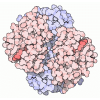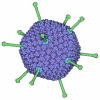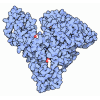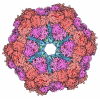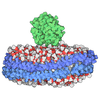+ Open data
Open data
- Basic information
Basic information
| Entry | Database: PDB / ID: 6ue8 | |||||||||
|---|---|---|---|---|---|---|---|---|---|---|
| Title | Structure of tetrameric sIgA complex (Class 1) | |||||||||
 Components Components |
| |||||||||
 Keywords Keywords | IMMUNE SYSTEM / immunoglobulin | |||||||||
| Function / homology |  Function and homology information Function and homology informationpolymeric immunoglobulin receptor activity / immunoglobulin transcytosis in epithelial cells mediated by polymeric immunoglobulin receptor / polymeric immunoglobulin binding / dimeric IgA immunoglobulin complex / secretory dimeric IgA immunoglobulin complex / pentameric IgM immunoglobulin complex / monomeric IgA immunoglobulin complex / secretory IgA immunoglobulin complex / Fc receptor signaling pathway / IgA binding ...polymeric immunoglobulin receptor activity / immunoglobulin transcytosis in epithelial cells mediated by polymeric immunoglobulin receptor / polymeric immunoglobulin binding / dimeric IgA immunoglobulin complex / secretory dimeric IgA immunoglobulin complex / pentameric IgM immunoglobulin complex / monomeric IgA immunoglobulin complex / secretory IgA immunoglobulin complex / Fc receptor signaling pathway / IgA binding / detection of chemical stimulus involved in sensory perception of bitter taste / IgA immunoglobulin complex / glomerular filtration / azurophil granule membrane / receptor clustering / immunoglobulin complex, circulating / immunoglobulin receptor binding / positive regulation of respiratory burst / humoral immune response / Scavenging of heme from plasma / complement activation, classical pathway / antigen binding / Cell surface interactions at the vascular wall / B cell receptor signaling pathway / epidermal growth factor receptor signaling pathway / antibacterial humoral response / protein-macromolecule adaptor activity / protein-containing complex assembly / blood microparticle / adaptive immune response / receptor complex / immune response / innate immune response / Neutrophil degranulation / protein homodimerization activity / extracellular space / extracellular exosome / extracellular region / plasma membrane Similarity search - Function | |||||||||
| Biological species |  Homo sapiens (human) Homo sapiens (human) | |||||||||
| Method | ELECTRON MICROSCOPY / single particle reconstruction / cryo EM / Resolution: 3 Å | |||||||||
 Authors Authors | Kumar, N. / Arthur, C.P. / Ciferri, C. / Matsumoto, M.L. | |||||||||
 Citation Citation |  Journal: Science / Year: 2020 Journal: Science / Year: 2020Title: Structure of the secretory immunoglobulin A core. Authors: Nikit Kumar / Christopher P Arthur / Claudio Ciferri / Marissa L Matsumoto /  Abstract: Secretory immunoglobulin A (sIgA) represents the immune system's first line of defense against mucosal pathogens. IgAs are transported across the epithelium, as dimers and higher-order polymers, by ...Secretory immunoglobulin A (sIgA) represents the immune system's first line of defense against mucosal pathogens. IgAs are transported across the epithelium, as dimers and higher-order polymers, by the polymeric immunoglobulin receptor (pIgR). Upon reaching the luminal side, sIgAs mediate host protection and pathogen neutralization. In recent years, an increasing amount of attention has been given to IgA as a novel therapeutic antibody. However, despite extensive studies, sIgA structures have remained elusive. Here, we determine the atomic resolution structures of dimeric, tetrameric, and pentameric IgA-Fc linked by the joining chain (JC) and in complex with the secretory component of the pIgR. We suggest a mechanism in which the JC templates IgA oligomerization and imparts asymmetry for pIgR binding and transcytosis. This framework will inform the design of future IgA-based therapeutics. | |||||||||
| History |
|
- Structure visualization
Structure visualization
| Movie |
 Movie viewer Movie viewer |
|---|---|
| Structure viewer | Molecule:  Molmil Molmil Jmol/JSmol Jmol/JSmol |
- Downloads & links
Downloads & links
- Download
Download
| PDBx/mmCIF format |  6ue8.cif.gz 6ue8.cif.gz | 418.5 KB | Display |  PDBx/mmCIF format PDBx/mmCIF format |
|---|---|---|---|---|
| PDB format |  pdb6ue8.ent.gz pdb6ue8.ent.gz | 336.3 KB | Display |  PDB format PDB format |
| PDBx/mmJSON format |  6ue8.json.gz 6ue8.json.gz | Tree view |  PDBx/mmJSON format PDBx/mmJSON format | |
| Others |  Other downloads Other downloads |
-Validation report
| Summary document |  6ue8_validation.pdf.gz 6ue8_validation.pdf.gz | 1.1 MB | Display |  wwPDB validaton report wwPDB validaton report |
|---|---|---|---|---|
| Full document |  6ue8_full_validation.pdf.gz 6ue8_full_validation.pdf.gz | 1.1 MB | Display | |
| Data in XML |  6ue8_validation.xml.gz 6ue8_validation.xml.gz | 67.3 KB | Display | |
| Data in CIF |  6ue8_validation.cif.gz 6ue8_validation.cif.gz | 102.7 KB | Display | |
| Arichive directory |  https://data.pdbj.org/pub/pdb/validation_reports/ue/6ue8 https://data.pdbj.org/pub/pdb/validation_reports/ue/6ue8 ftp://data.pdbj.org/pub/pdb/validation_reports/ue/6ue8 ftp://data.pdbj.org/pub/pdb/validation_reports/ue/6ue8 | HTTPS FTP |
-Related structure data
| Related structure data |  20750MC  6ue7C  6ue9C  6ueaC M: map data used to model this data C: citing same article ( |
|---|---|
| Similar structure data |
- Links
Links
- Assembly
Assembly
| Deposited unit | 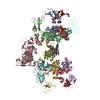
|
|---|---|
| 1 |
|
- Components
Components
-Antibody / Protein / Immunoglobulin ... , 3 types, 10 molecules ABFGEHKLCD
| #1: Antibody | Mass: 26682.146 Da / Num. of mol.: 8 / Fragment: UNP residues 110-340 Source method: isolated from a genetically manipulated source Source: (gene. exp.)  Homo sapiens (human) / Gene: IGHA2 / Production host: Homo sapiens (human) / Gene: IGHA2 / Production host:  #2: Protein | | Mass: 65154.094 Da / Num. of mol.: 1 / Fragment: UNP residues 19-603 Source method: isolated from a genetically manipulated source Source: (gene. exp.)  Homo sapiens (human) / Gene: PIGR / Production host: Homo sapiens (human) / Gene: PIGR / Production host:  #3: Protein | | Mass: 15611.458 Da / Num. of mol.: 1 / Fragment: UNP residues 23-159 Source method: isolated from a genetically manipulated source Source: (gene. exp.)  Homo sapiens (human) / Gene: JCHAIN, IGCJ, IGJ / Production host: Homo sapiens (human) / Gene: JCHAIN, IGCJ, IGJ / Production host:  |
|---|
-Sugars , 3 types, 7 molecules 
| #4: Polysaccharide | 2-acetamido-2-deoxy-beta-D-glucopyranose-(1-4)-2-acetamido-2-deoxy-beta-D-glucopyranose Source method: isolated from a genetically manipulated source |
|---|---|
| #5: Polysaccharide | beta-D-mannopyranose-(1-4)-2-acetamido-2-deoxy-beta-D-glucopyranose-(1-4)-2-acetamido-2-deoxy-beta- ...beta-D-mannopyranose-(1-4)-2-acetamido-2-deoxy-beta-D-glucopyranose-(1-4)-2-acetamido-2-deoxy-beta-D-glucopyranose Source method: isolated from a genetically manipulated source |
| #6: Sugar | ChemComp-NAG / |
-Details
| Has ligand of interest | N |
|---|---|
| Has protein modification | Y |
-Experimental details
-Experiment
| Experiment | Method: ELECTRON MICROSCOPY |
|---|---|
| EM experiment | Aggregation state: PARTICLE / 3D reconstruction method: single particle reconstruction |
- Sample preparation
Sample preparation
| Component | Name: tetrameric sIgA complex (Class 1) / Type: COMPLEX / Entity ID: #2-#3, #1 / Source: RECOMBINANT |
|---|---|
| Molecular weight | Value: 0.294 MDa / Experimental value: NO |
| Source (natural) | Organism:  Homo sapiens (human) Homo sapiens (human) |
| Source (recombinant) | Organism:  |
| Buffer solution | pH: 7.2 |
| Specimen | Embedding applied: NO / Shadowing applied: NO / Staining applied: NO / Vitrification applied: YES |
| Specimen support | Details: unspecified |
| Vitrification | Instrument: FEI VITROBOT MARK IV / Cryogen name: ETHANE / Humidity: 100 % / Chamber temperature: 277 K |
- Electron microscopy imaging
Electron microscopy imaging
| Experimental equipment |  Model: Titan Krios / Image courtesy: FEI Company |
|---|---|
| Microscopy | Model: FEI TITAN KRIOS |
| Electron gun | Electron source:  FIELD EMISSION GUN / Accelerating voltage: 300 kV / Illumination mode: FLOOD BEAM FIELD EMISSION GUN / Accelerating voltage: 300 kV / Illumination mode: FLOOD BEAM |
| Electron lens | Mode: BRIGHT FIELD / C2 aperture diameter: 100 µm |
| Specimen holder | Cryogen: NITROGEN / Specimen holder model: FEI TITAN KRIOS AUTOGRID HOLDER |
| Image recording | Average exposure time: 10 sec. / Electron dose: 51.91 e/Å2 / Film or detector model: GATAN K2 SUMMIT (4k x 4k) |
| EM imaging optics | Energyfilter name: GIF Bioquantum / Energyfilter slit width: 20 eV |
- Processing
Processing
| EM software |
| ||||||||||||
|---|---|---|---|---|---|---|---|---|---|---|---|---|---|
| CTF correction | Type: PHASE FLIPPING AND AMPLITUDE CORRECTION | ||||||||||||
| Symmetry | Point symmetry: C1 (asymmetric) | ||||||||||||
| 3D reconstruction | Resolution: 3 Å / Resolution method: FSC 0.143 CUT-OFF / Num. of particles: 131610 / Symmetry type: POINT |
 Movie
Movie Controller
Controller






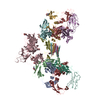
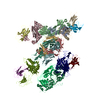
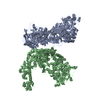
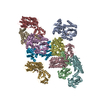

 PDBj
PDBj




